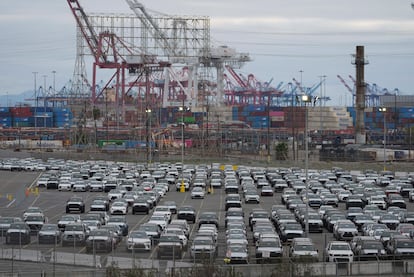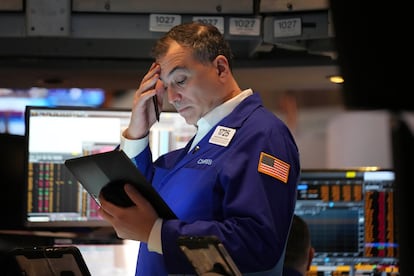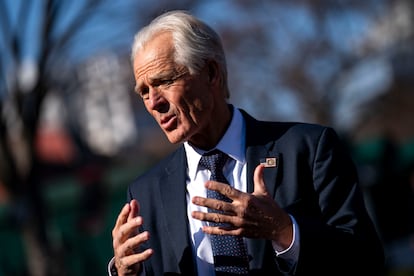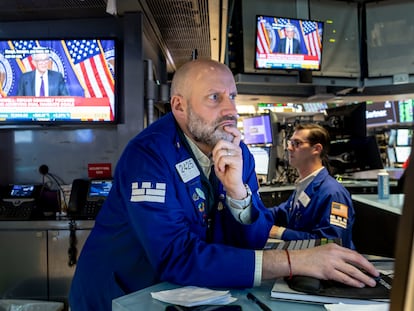Trump’s trade war threatens to trigger a recession in the United States
Uncertainty about the tariffs to be applied and possible retaliation from its trading partners is already having an impact on the economy


The U.S. economy was recently the envy of the world, with a low unemployment rate, strong growth, and inflation almost under control. In just over two months, the damage caused by Donald Trump’s economic policies threatens to plunge the world’s leading power into recession. The president is preparing to launch the most severe wave of the trade war he has declared against the world with what he calls “reciprocal” tariffs, which are anything but. The uncertainty generated by his erratic announcements has already weakened the economy before April 2, which he calls “Liberation Day.”
The stock market, which Trump cites when it rises as a testament to his economic success, has only been going down lately. “I hear it from nearly every client, nearly every leader — nearly every person — I talk to: they’re more anxious about the economy than any time in recent memory. I understand why. But we have lived through moments like this before. And somehow, in the long run, we figure things out,” said BlackRock Chairman Larry Fink, attempting to see the glass half full, at the beginning of his annual letter to investors.
The S&P 500 index closed its worst quarter in nearly three years, down 4.6%. Investors are fleeing risky assets in search of safe havens, and even the dollar has ceased to function as such, which has particularly boosted gold, whose price has broken records and experienced its best quarter since 1986. Meanwhile, the global economy is preparing for the impact of Trump’s trade war. Economists assume that the protectionist aggression of its powerful neighbor will push Mexico and Canada into recession. The outlook is also bleak for the European Union, but Trump is also shooting himself in the foot, and the risk of an economic crisis in the United States continues to grow.

“I’m raising my odds that a recession will begin sometime this year to 40%, up from 15% at the start of the year,” Moody’s chief economist Mark Zandi said Sunday in a post on X. “Last week’s economic data were disconcerting, including the slide in consumer confidence, punk consumer spending, and persistently high inflation. The intensifying trade war and DOGE cuts are behind all this and with last week’s announcement of big tariff increases on vehicle imports and the coming reciprocal tariffs, things are sure to get worse.”
It’s not even clear what the announcement will consist of or when the new tariffs will be implemented. The president, perhaps aware of the damage he’s causing with them, has been trying to downplay their impact. “The tariffs will be far more generous than those countries were to us, meaning they will be kinder than those countries were to the United States of America over the decades,” he said this past Sunday aboard Air Force One. “They ripped us off like no country has ever been ripped off in history, and we’re going to be much nicer than they were to us. But it’s substantial money for the country nevertheless,” he added, indicating that tariffs will be announced for virtually all countries.
China, the European Union, Mexico, Vietnam, Taiwan, Japan, South Korea, Canada, India, Thailand, Switzerland, and Malaysia are the countries or blocs with which the United States has the largest trade deficit. They appear to be the most threatened, regardless of their own tariffs on U.S. products. Each is preparing its own retaliation or negotiating strategy. There is no way to anticipate the level of the “reciprocal” tariffs Trump will announce, as they do not respond to objective criteria, but rather to a somewhat arbitrary decision. It is also unclear to what extent they are a negotiating tool or a permanent trade barrier intended to raise revenue.
Peter Navarro, one of Trump’s top trade advisers, said Sunday that he expects the tariffs to generate $600 billion in annual revenue. Even without reaching that figure, it would be the largest tax increase approved by a president in decades.

Analysts at the investment bank Goldman Sachs expect the average U.S. tariff rate to rise by 15 percentage points this year, five percentage points higher than their previous forecast, and expect Trump to announce “reciprocal” tariffs averaging 15% across all of his trading partners on Wednesday.
Interest rates
The investment bank estimates there is a 35% risk that the United States will enter a recession in the next 12 months, compared to the 20% it previously estimated. Goldman has lowered its forecast for gross domestic product (GDP) growth this year from 2% to 1.5% on average, with just 1% year-over-year growth in the fourth quarter. Given the economic slowdown, its analysts now predict three 0.25-point interest rate cuts by the Federal Reserve, to be approved in July, September, and November. This is despite the fact that they expect the tariffs to push inflation to 3.5%. JP Morgan, the largest bank in the United States, recently put the probability at 40%, also citing the tariffs.
The uncertainty is already having adverse economic effects. Last week, the Federal Reserve Bank of Atlanta projected a possible severe economic contraction in the first quarter of the year following the release of several negative indicators.
According to Oxford Economics, American consumers are fed up, and their confidence is at recession-like levels amid growing fears of higher inflation and a deteriorating economic outlook. “We may convince ourselves we’re in a recession, just as rising inflation expectations can become a self-fulfilling prophecy,” notes Bob Schwartz, an economist at the firm. “But it’s hard to know when feelings have a significant impact on behavior. The economy has performed well in the past when households were struggling, but such a gloomy, pessimistic mindset so far removed from a recession is rare, especially after a year of exceptional results,” he adds. According to Schwartz, there are signs that the dismal confidence readings are beginning to dampen consumer spending.
The so-called reciprocal tariffs are being added to the rest of the protectionist measures imposed by Trump. The United States is already applying 25% tariffs on aluminum and steel imports. It has imposed additional 20% tariffs on Chinese imports (except for small imports, which its customs offices were unable to process). Furthermore, it is also imposing a 25% tariff on some imports from Mexico and Canada, although it has granted a moratorium until April 2 for the vast majority, those that meet the requirements of the current free trade agreement between the three countries.
The president announced last week that starting April 3, he will impose 25% tariffs on imported light vehicles and components, which will increase the price of both imported and domestically manufactured cars. Starting this Wednesday, Secretary of State Marco Rubio will also be able to impose 25% tariffs on all countries that import Venezuelan oil. Trump has threatened secondary tariffs on Russia and Iran and has sector-specific tariffs on pharmaceuticals, microprocessors, copper and lumber, among other products, in the pipeline. The possibility of a generalized universal tariff on all imports is also on the table.
It's not even clear whether the outlook will clear up this week. April 2 could end up simply being a "springboard for future negotiations," Morgan Stanley analysts warn. "This means that political uncertainty and growth risks are likely to persist; it's a question of how far they will go," they note. Doubts also extend to possible retaliation from trading partners.
Even if the tariffs end up being less harsh than feared, the uncertainty created could alone cause American households and businesses to freeze their spending, hurting an economy that had been growing at a healthy pace until Trump's election victory.
Among the next indicators to watch is the March jobs report, which is released this Friday. “It is premature to expect much fallout from the trade war and DOGE cuts in the jobs data, suggesting a monthly payroll job gain of close to 150,000. Anything south of 100k would be worrisome, and anything north of 200k would be welcome,‚” says Moody’s Zandi. “But whatever the job number, as long as the tariffs and DOGE cuts continue to mount, so too will the odds of recession.”
Sign up for our weekly newsletter to get more English-language news coverage from EL PAÍS USA Edition
Tu suscripción se está usando en otro dispositivo
¿Quieres añadir otro usuario a tu suscripción?
Si continúas leyendo en este dispositivo, no se podrá leer en el otro.
FlechaTu suscripción se está usando en otro dispositivo y solo puedes acceder a EL PAÍS desde un dispositivo a la vez.
Si quieres compartir tu cuenta, cambia tu suscripción a la modalidad Premium, así podrás añadir otro usuario. Cada uno accederá con su propia cuenta de email, lo que os permitirá personalizar vuestra experiencia en EL PAÍS.
¿Tienes una suscripción de empresa? Accede aquí para contratar más cuentas.
En el caso de no saber quién está usando tu cuenta, te recomendamos cambiar tu contraseña aquí.
Si decides continuar compartiendo tu cuenta, este mensaje se mostrará en tu dispositivo y en el de la otra persona que está usando tu cuenta de forma indefinida, afectando a tu experiencia de lectura. Puedes consultar aquí los términos y condiciones de la suscripción digital.
More information
Archived In
Últimas noticias
The new language of the workplace: Knowing how to ask AI questions is more important than using it
Christmas loses its festive spirit: ICE fears cast shadow over religious celebrations
‘Sleepless City’: The light of cinema illuminates Madrid’s Cañada Real shantytown
All the effects of gentrification in one corner of Mexico’s Colonia Roma
Most viewed
- The low-cost creative revolution: How technology is making art accessible to everyone
- Christian Louboutin: ‘Young people don’t want to be like their parents. And if their parents wear sneakers, they’re going to look for something else’
- US sanctions against jailed cartel leader ‘El Marro’ highlight Mexico’s lack of control over its prisons
- Liset Menéndez de la Prida, neuroscientist: ‘It’s not normal to constantly seek pleasure; it’s important to be bored, to be calm’
- Cartels in Mexico take a leap forward with narco-drones: ‘It is criminal groups that are leading the innovation race’










































